The following article was written for MyIndMakers. Pasting it here for reference.

In the city of Siem Reap, Cambodia, we (a group of 4) were introducing ourselves to the tour guide in the hotel lobby. My introduction was uneventful. The guide's expression changed when my wife introduced herself. I was sure she found the name difficult to pronounce, so I tried to offer help! The guide didn't bother - and with a perplexed look, asked my wife - "Your name is Pragnya? Pragnya means knowledge in Cambodia, THAT Pragnya?" It was now our turn to get perplexed! This was the first indication of how close our ancient cultures were. But this was no indication of the awesomeness that was to follow for the next 3 days.
Angkor Wat
Siem Reap in Cambodia is famous for the World’s largest temple – Angkor Wat. Given the ease with which information is available in these days, we knew a bit about the history of this temple. But nothing prepares you for the majesty of Angkor Wat when you actually see it – the sheer size of it blows you away. From land, a picture of the entire complex cannot be captured. We took a 10 minute balloon “ride” just to see this awesomeness in its entirety as you can see in the picture above.
However, the beauty of this temple does not just lie in the size, but in its intricate architecture. I never knew that this Buddha is considered as the 9th Avatar of Vishnu. One of the first sightings in the temple complex is this huge standing statue of Buddha with multiple hands! This was one of the biggest surprises to – for I never even knew Buddha was worshipped in this form too!
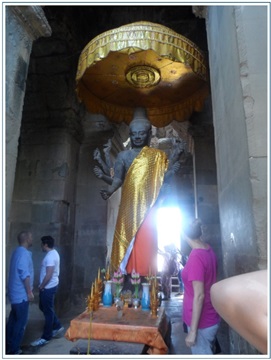
There are about 9 gopuras (towers) in this temple – each of them has multiple Buddha statues in various forms. If memory serves me right, there are more than 50 Buddha statues in the complex of Angkor Wat.
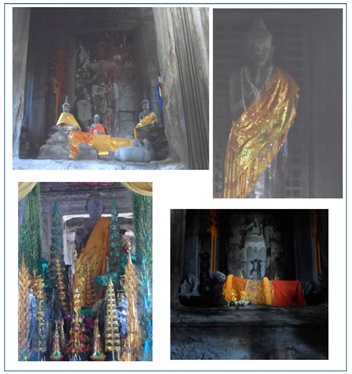
At this point of time, I wouldn’t blame you if you started thinking this – “Ok, basically this is a temple with a lot of Buddha Statues”. This was one of the thoughts going through my mind too, when the tour guide bought us to this wall with a lot of pictorial inscriptions on it.
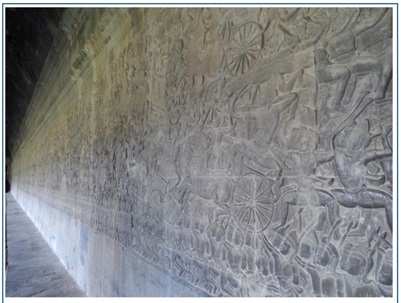
This is a pictorial description of the Mahabharata War! We were simply astounded – there was no way I could see this coming! Here I am, in a far away land, looking at the pictorial description of the Mahabharata war and a tour guide telling us about the various characters and what they are doing in the war! We were also clarifying a few doubts that the guide had from a long time J - turned out to be a mutually beneficial tour! The guide was like this story is so complex – to which I told her that this is the beauty of the Mahabharata – there is nothing black and white in it!
Not just the Mahabharata – there were pictorial inscriptions of Ramayana and the Sagar Manthan too. This is something I never expected and was truly bowled over to know that these stories extended way beyond the present Indian boundaries.
Angkor Thom
The next stop is Angkor Thom – a vast area in which multiple temples were built. Phew – again temples? Wait till you see the first one – the Bayon.
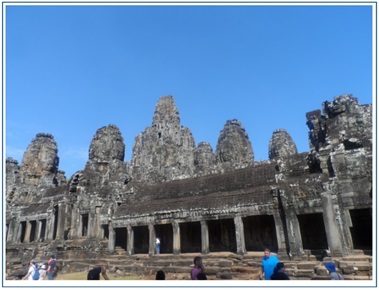
This image is just a cross-section of the entire temple complex. Since this is a long shot, let me present to you a close up of one of the towers.
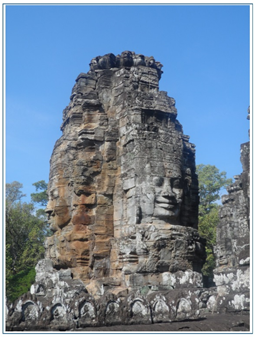
The temple complex has more than 50 such exquisite and beautifully carved out Buddhas – what brilliance must have existed in those days to have come up with such superb architecture! There are other structures in Angkor Thom area that are equally stunning!
Bayon and other temples also nice intricate art on their walls. These depict lifestyles of people – boating, farming, archery, hunting, dancing, even delivery of a baby!
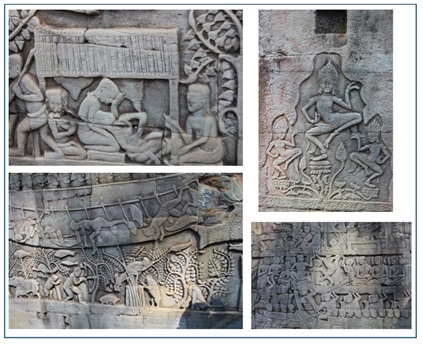
Banteay Srei
This was one of the last places we visited, because this is a little far from Siem Reap. I was not too excited because by now, we have seen enough temples. But after seeing this temple, felt a tinge of regret of not being able to come here earlier! This temple is an ode to Shiva, Vishnu and Brahma! The intricate carvings that depict the Ramayana and the various avatars of Vishnu are a treat to watch. In the below collage, note the superb carving of the 10-headed Ravana. Various other events of the Ramayana are also carved as beautifully as this.
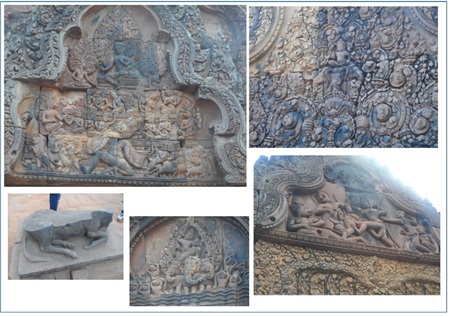
Many of these heritage sites are undergoing a lot of renovation. Various governments are helping with renovating. Indian government is involved with renovating the Ta Phrom temple. This temple is famous for being held by trees (and for the film shooting of Tomb Raider!).
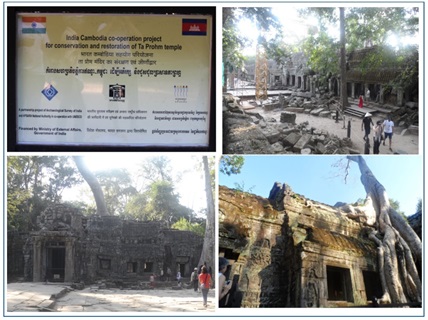
The land of thousand lingas
Let’s move away from Buddha and temples for a while J. We were taken atop a hill which was called the Land of Thousand Lingas. So I presumed that on the hill someone built a lot of lingas, and hence the name (And there will not be a 1000 lingas for sure!). I was right – there were no 1000 lingas. There were perhaps ~5000 lingas!! A river flows on top of the hill, and all of these lingas were build on the river bed – so essentially you get to see the lingas below the flowing water. This is a sight that can only be experienced and cannot be adequately described in words.
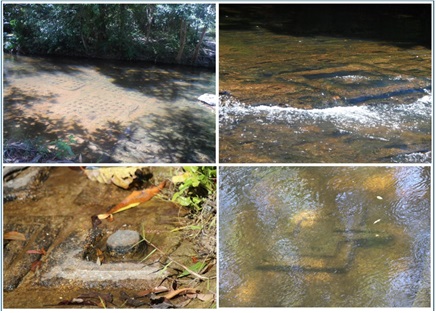
It was plain fascinating to know that a king, more than 1000 years ago thought about an idea like this and had this implemented with such precision. The river bed also has a carving of Lord Vishnu and Lakshmi devi too. Unfortunately, I couldn’t capture it well on my camera.
Just nearby to this hill is another small hill on top of which is a very large sized Buddha statue – I forgot the name of this place, but this was carved out of the rock on the hill itself.
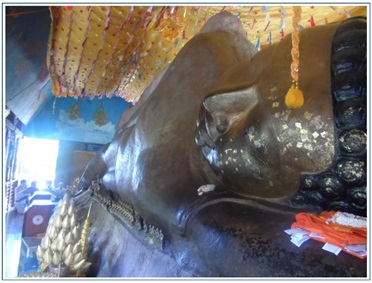
Worshipping of the Naga
One other new thing we have learnt is that the Naga is a worshipped here a lot. Almost every single entrance has a Naga. A few bridges have the “Sagar Manthan” as the barricades. We went to a hill, en route Phnom Penh to Siem Repp and the railing for the entire stairs was the “Sagar Manthan”. There are many statues of Naga Buddha too. Nagas are essentially prevalent everywhere you go!
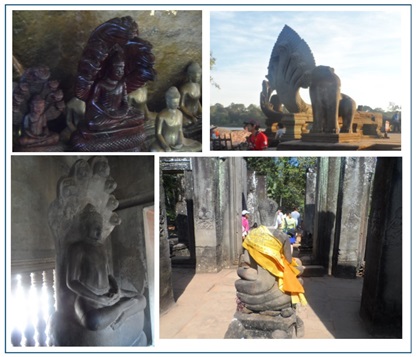
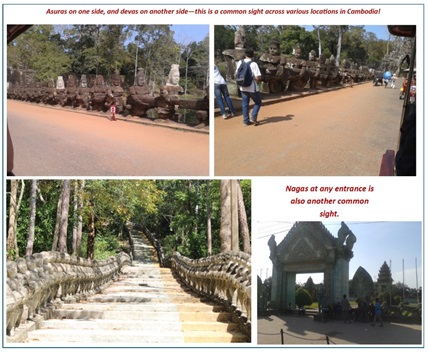
A country with a rich ancient history, but a sad and gory recent history
The first city we landed in was Phnom Penh – the capital city of Cambodia. People insist that we visit the “Killing Fields Musuem” to know and learn about the sad and gory years of the 70s and 80s. The people of Cambodia had to face the wrath of one of the worst dictators to have ever graced our planet – Pol Pot. His party – the Khmer Rougue – went on a murdering spree. Anyone who is educated, anyone who has any skill other than farming, anyone raising their voice against the Khmer. A whopping 30 lakh people out of a population of 50 lakh people were killed by Pol Pot and his minions. Many buildings were razed to the ground. It is a miracle that the Angkor Wat was not touched (actually a bigger miracle that it was not touched by the muslim invaders in the ancient past too!).
The killing fields are a chilling reminder of this past. The mass graves, the hundreds of skulls in the museum, bits and pieces of cloths coming out from the roots of the trees – not only will this trip leave you depressed but one cannot but be thankful for having gotten such a privileged life when compared to the generations that have been wiped out.
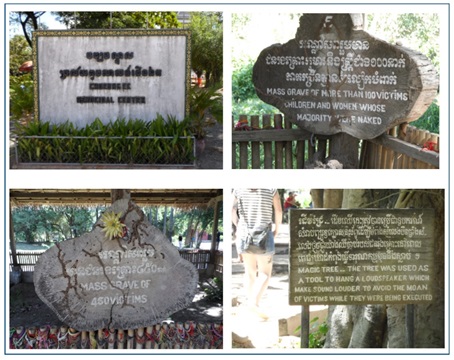
This is also one of the main reasons for the poverty prevalent in the country. Due to poverty, heads of various statues across these heritage sites have been looted. Statues without their heads are a very common sight in many of the temples including the Angkor Wat.
Cambodians now are hell bent on rebuilding themselves. Tourism and hospitality are their major attractions and revenue generating industry. Poor children are trained well in both these industries. The manager at the hotel we stayed in Phonm Penh (whose name was Mani J ) explained to us how this training happens.
There is also a 4 year degree course in tourism – only if you pass this course will you be recognized as a guide! As part of this course, the history, geography and politics of various countries are also taught, so that the guides can connect well with the visitors!The people of Cambodia are so humble and most of them we met were so hard working, we really felt there is a lot to learn from them.
Now to the most important part – Food
I strongly believe food is a very integral part of the history and culture of any nation. The longer the history of the nation, the richer the variety in food. Cambodia was no exception! First thing I learnt was that no one drinks milk in Cambodia. Their staple liquid diet is Coconut water! They dice it beautifully so that it sits well on the table! Various curries are also served in the Coconut J. Another interesting way of serving is to wrap the food in banana leaf – particularly the fish amok (which is also very tasty). I purchased the “amok” powder to try this at home and failed miserably to get the taste! Street food is also widely available – they look enticing but we tried only bits and pieces of this food.
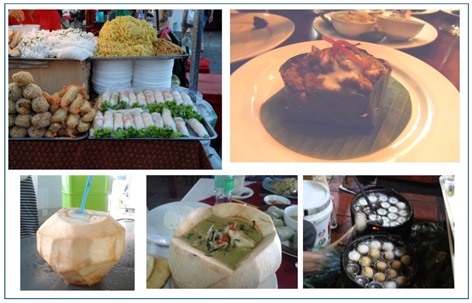
The politics
It takes about 7 hours to cover the 300kms distance from Phnom Penh to Siem Reap. There are a couple of hills around Siem Repp which are good tourist locations. All along these routes, we were intrigued to find the banners of only one political party (even in some very remote locations, we saw these banners!).
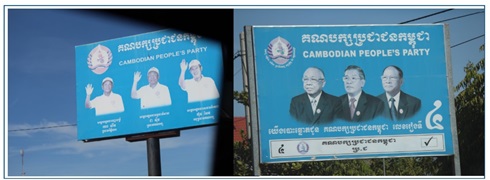
The guide told us this party and its president have been ruling them since 1992 – when democracy first came to Cambodia. We were very quickly able to identify with this scenario.
One last thing.
Following is the image of a screen grab on one of their TV channels.
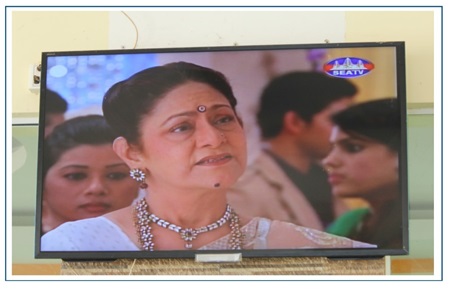
Geographically we maybe far, but culturally we are quite near – back then and even now !

